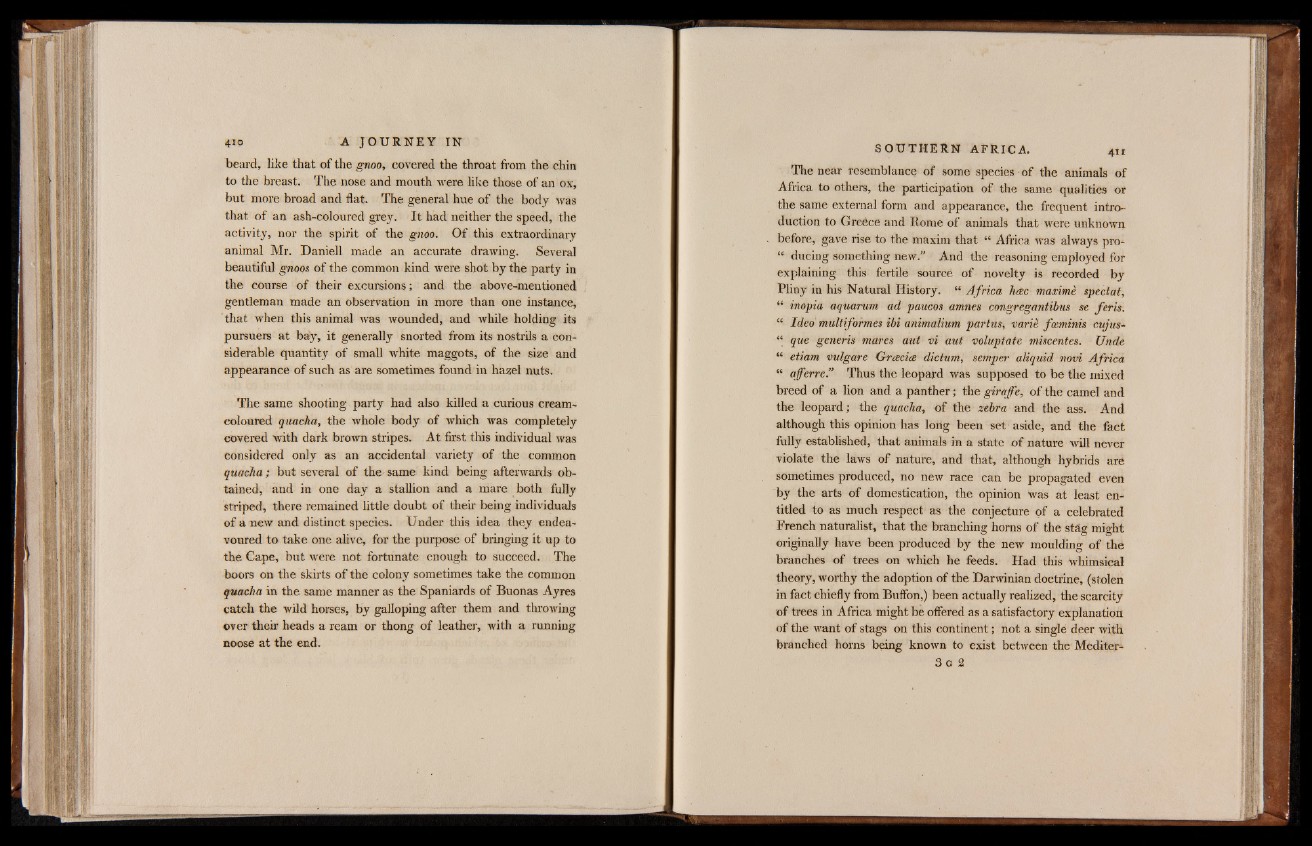
beard, like that of the gnoo, covered the throat from the chin
to the breast. The nose and mouth were like those of an ox,
but more broad and flat. The general hue of the body was
that of an ash-coloured grey. I t had neither the speed, the
activity, nor the spirit of the gnoo. Of this extraordinary
animal Mr. Daniell made an accurate drawing. Several
beautiful gnoos of the common kind were shot by the party in
the course of their excursions; and the above-mentioned
gentleman made an observation in more than one instance,
that when this animal was wounded, and while holding its
pursuers at bay, it generally snorted from its nostrils a considerable
quantity of small white maggots, of the size and
appearance of such as are sometimes found in hazel nuts.
The same shooting party had also killed a curious cream-
coloured quacha, the whole body of which was completely
covered with dark brown stripes. At first this individual was
considered only as an accidental variety of the common
quacha; but several of the- same kind being afterwards obtained,
and in one day a stallion and a mare both fully
striped, there remained little doubt of their being individuals
of a new and distinct species. Under this idea they endeavoured
to take one alive, for the purpose of bringing it up to
the Cape, but were not fortunate enough to succeed. The
boors on the skirts of the colony sometimes take the common
quacha in the same manner as the Spaniards of Buonas Ayres
catch the wild horses, by galloping after them and throwing
over their heads a ream or thong of leather, with a running
noose a t the end.
The near resemblance of some species of the animals of
Africa to others, the participation of the same qualities or
the same external form and appearance, the frequent introduction
to Greëce and Rome of animals that were unknown,
before, gave rise to the maxim that “ Africa wras always pro-
“ ducing something new.” And the reasoning employed for
explaining this fertile source of novelty is recorded by
Pliny in his Natural History. “ Africa hæc maxime spectat,
“ inopia aquarum ad. paucos amnes congregantibus se feris.
“ Ideo multiformes ibi animalium partus, varié foeminis cujus-
“ qtte generis mares aut vi aut voluptate miscentes. Unde
“ etiam vulgare Gracice dictum, semper aliquid novi Africa
“ afferre.” Thus the leopard was supposed to be the mixed
breed of a lion and a panther ; the giraffe, of the camel and
the leopard ; the quacha, of the zebra and the ass. And
although this opinion has long been set aside, and the fact
fully established, that animals in a state of nature will never
violate the laws of nature, and that, although hybrids are
sometimes produced, no new race can be propagated even
by the arts of domestication, the opinion was at least entitled
to as much respect as the conjecture of a celebrated
French naturalist, that the branching: horns ¡PI' of the stâgO: mi<Odit
originally have been produced by the new moulding of the
branches of trees on which he feeds. Had this whimsical
theory, worthy the adoption of the Darwinian doctrine, (stolen
in fact chiefly from Buffon,) been actually realized, the scarcity
of trees in Africa might be offered as a satisfactory explanation
of the want of stags on this continent ; not a single deer with
branched horns being known to exist between the Mediter-
3 g 2